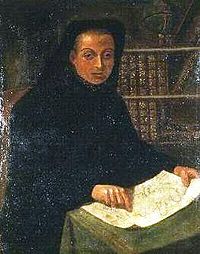Louis Feuillée Scientist
Louis Éconches Feuillée (sometimes spelled Feuillet) (1660, Mane, Alpes-de-Haute-Provence – April 18, 1732) was a French member of the Order of the Minims, explorer, astronomer, geographer, and botanist.Feuillée was educated at the Minim convent of Mane, in Provence. He was born in Mane, near Forcalquier, in 1660. He was taught astronomy and cartography by Jean Mathieu de Chazelles, and Charles Plumier, who had described some 6,000 species of plants during a voyage to the Caribbean, taught him botany. He attracted the attention of members of the Academy of Sciences and in 1699 was sent by order of the king on a voyage to the Levant with Giovanni Domenico Cassini to determine the geographical positions of a number of seaports and other cities. The success of the undertaking led him to make a similar journey to the Antilles in 1703. He left Marseilles on February 5, 1703, and arrived at Martinique on April 11.A severe sickness was the cause of considerable delay, but in September of the following year he began a cruise along the northern coast of South America, making observations at numerous ports.In the Antilles, he collected new species of flora and drew a map of Martinique; he also explored the Venezuelan coast. He returned to France in June 1706. his work won recognition from the Government, and he immediately began preparations for a more extended voyage along the western coast of South America to continue his observations. He received the title of "Royal Mathematician" from Louis XIV of France, and armed with letters from the ministry, set sail from Marseilles on December 14, 1707. In 1707, he voyaged to what is now Argentina, rounded Cape Horn at the end of 1708 after a tempestuous voyage, and arrived at Concepción, Chile on January 20, 1708. He remained in that city for a month, conducting astronomic, botanical, and zoological surveys and at the end of February traveled to Valparaíso. He then traveled to Peru and returned to France in August 1711, where he published a complete inventory of his observations in three volumes (1714–1725). Louis XIV granted him a pension and built an observatory for him at the convent on the Michaelmas Plain at Marseilles.The Spanish colonies of Central and South America seemed to have received many visits by French scientists during this period. These men served both as unofficial "scientific advisors" –but also as spies. Between 1735 and 1744, scientists like Louis Godin, Charles Marie de La Condamine, and Pierre Bouguer would take part in similar expeditions.He died at Marseilles.
